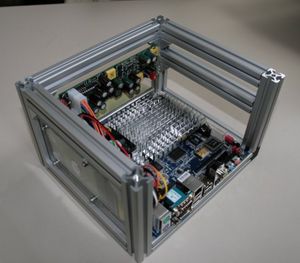Difference between revisions of "PCBricks"
| Line 15: | Line 15: | ||
By the way, the processor fan is absolutely silent in any condition: something that could not be said of previous VIA mini-ITX boards, and that can be required for some applications. | By the way, the processor fan is absolutely silent in any condition: something that could not be said of previous VIA mini-ITX boards, and that can be required for some applications. | ||
| − | In the AIRLab | + | In the AIRLab '''five PCBricks''' are available. Three of them are currently used by the [[Rawseeds]] project and two by the [[LURCH - The autonomous wheelchair|LURCH]] project. |
Revision as of 10:48, 24 April 2008
A PCBrick is a complete x86-compatible PC, designed for maximum modularity in terms of mechanical construction and data interface provision. It has been designed explicitly for robotic applications, and it is fitted with a DC power supply. The main design goal has been to minimize power consumption while maintaining acceptable performance of the single PCBrick: if more computing power is required, multiple PCBricks can be used. In this way the use of powerful and power-hungry PCs can be confined to the applications where they are really necessary.
A single PCBrick has a power consumption that never exceeds 25W, and is still lower when the processor is not under heavy computational load.
The PCBrick design is based on the use of motherboards with mini-ITX form factor (17cm x 17cm). Presently, the PCBrick mount VIA EN15000 motherboards, fitted with a single-core VIA C7 processor having a clock frequency of 1.5GHz, and with an extensive set of interfaces. An aluminum frame is used, made with Item profiles, for easy mechanical connections to external systems. Included in the frame of the PCBrick are an 80GB hard disk (Hitachi HTS721080G9AT00: 2,5”, 7200RPM, Parallel ATA), 1GB of DDR2 RAM (400/533MHz DIMM, 1GB maximum) and a DC power supply accepting from 6V DC to 24V DC. The frame includes the space necessary for the fitting of PCI card into the (single) slot of the motherboard, and fixtures for the mounting of additional hardware.
If necessary, on a PCBrick can be mounted two PCI cards. However, that can only be accomplished by mounting the cards horizontally, and requires the use of an L-shaped PCI adapter board (available). The horizontal mounting of PCI cards can easily be accomodated by removing from the frame of the PCBrick a pillar, kept in place by a single screw. Note, however, that horizontally-mounted PCI cards will extend out from the PCBrick frame, and that suitable fixing points and protection for them must be realized.
Of course the use of the PCI adapter described above also allows for the horizontal mounting of a single PCI card, but it's hard to think of a case in which this kind of mounting is so needed that the awkwardness of having a card sticking out from the PC and needing external fixing points can be overlooked.
The weak point of the PCBrick is (by design) the low computing power. Don't expect to run software needing heavy computation without hitting the limits of the processor. For example, compiling the Linux kernel on a PCBrick is an experience that any sane man or woman would avoid (and yet is necessary if you want to extract every last gram of that limited performance). On the other hand, the disk is fast (generally 2.5" disks have a 5400RPM rotational speed) and the interfaces are comprehensive, so the logging of substantial amounts of data - even from multiple sources - is possible, as it requires limited intervention of the processor.
By the way, the processor fan is absolutely silent in any condition: something that could not be said of previous VIA mini-ITX boards, and that can be required for some applications.
In the AIRLab five PCBricks are available. Three of them are currently used by the Rawseeds project and two by the LURCH project.
